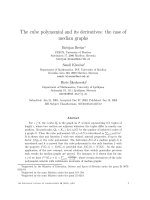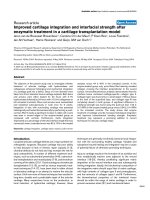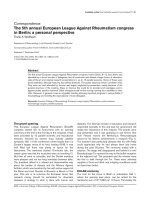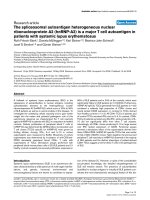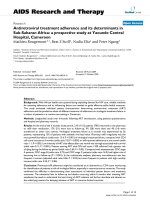Báo cáo y học: "The EVIDEM framework and its usefulness for priority setting across a broad range of health interventions" docx
Bạn đang xem bản rút gọn của tài liệu. Xem và tải ngay bản đầy đủ của tài liệu tại đây (171.5 KB, 3 trang )
COMM E N TAR Y Open Access
The EVIDEM framework and its usefulness for
priority setting across a broad range of health
interventions
Sitaporn Youngkong
1,2*
, Noor Tromp
1†
and Dereck Chitama
1,3†
Commentary
This commentary responds to the article by Goetghe-
beur et al [1], which applies the EVIDEM (Evidence and
Value: Impact on DEci sion-Making) framework to eval-
uate growth hormone therapy for Turner syndrome
patients. The EVIDEM framework is developed to assist
decision-makers in healthcare decisions, and encom-
passes a multi-criteria decision analysis (MCDA) matrix
consisting of 15 quantifiable, and six qualitative compo -
nents of decision. With this comprehensive set of cri-
teria, relevant experts can assess the performance of
health interventions, and results are input for informed
and transparent healthcare decisions.
Goetghebeur et al [1] propose that the EVIDEM can
be used to compare various i nterventi ons across disease
areas in order to prioritize interventions. They suggest
that the EVIDEM can analyze single interventions, and
the performance of competing interventions can subse-
quently be compared in a p erformance matrix. While
we value the qualities of the EVIDEM because of its
scope and breadth, we have doubts on the results con-
sistency of the EVIDEM to compare competing inter-
ventions, particularly when setting priorities across
broad healthcare service areas (e.g. in designing the
national health benefit package) for two main reasons.
First, the EVIDEM framework igno res the contextual
nature of prio rity setting process by assuming a set of
universal priority setting criteria [2]. In reality, the prior-
ity setting process is context specific and different sets
of criteria lead priority setting of health interventions in
different contexts. As the examples of studies in Nepal
[3], Chile [4], and Ghana [5] show, the set of criteria
identified for using in priority setting of health interven-
tions were differ ent between countries. Therefore, we
suggest that the setting of prioritization criteria needs to
be locally determined or verified, implying that the EVI-
DEM needs to be flexible to allow change/modification
of the components to suit the local context.
Secondly, the EVIDEM is vulnerable to interventions
ranking inconsistency where performance evaluation of
a broad range of competing interventions is mandated.
For example, the EVIDEM framework requires different
expert panels to assess the performance of ev ery single
intervention separately. This may lead to inconsistency
of the results as differen t expert panels may have differ-
ent considerations across the broad range of interven-
tions to be assessed. As shown in the EVIDEM Turner
Syndrome case study [1], the panel of experts estimated
growth hormone intervention to achieve 41% of maxi-
mum value. However, in the absence of established
explicit weights of criteria, it is not certain that the
same panel will be consistent in evaluating different
interventions, or that another panel of experts comes up
with the same or similar value.
These arguments raise the question whether the
approach of EVIDEM is locally meaningful and consis-
ten t when priorities are set for a range of interventions.
To address its limitations, we propose a s tepwise pro-
cess to identify criteria and the ir weights, and rank
ordered interventions.
We suggest that, to set priorities of a range of inter-
ventions within a certain context, a locally-meaningful
set of criteria and their relative importance (i.e. weights)
should be elicited by consulting relevant stakeholders.
As a next step, the identified set of criteria and weights
are then used to consistently assess the performa nce of
the broad range of interventions.
To illustrate the method, we describe a study in Thai-
land [6], which defined explicit criteria to prioritize
health int erventions f or the nat ional health benefit
* Correspondence:
† Contributed equally
1
Nijmegen International Center for Health Systems Research and Educat ion
(NICHE), Department of Primary and Community Care, Radboud University
Nijmegen Medical Centre, Nijmegen, The Netherlands
Full list of author information is available at the end of the article
Youngkong et al. Cost Effectiveness and Resource Allocation 2011, 9:8
/>© 2011 Youngkong et al; licens ee BioMed Central Ltd. This is an Open Access article distributed under the terms of the Creative
Commons Attribution License ( which permits unrestricted use, distribution, and
reproduction in any medium, provided the original work is properly cited.
package. Our study was conducted in five main steps.
First, in a group discussion among multi-stakeholders,
the six most important prioritization criteria (and their
levels) were identified i.e. type of intervention, target
groups of intervention, severity of disease, number of
beneficiaries, value for money, and budget impact. This
step ensured that the c riteria was verified for the Thai
context. Second, based on those six criteria, we designed
a discrete choice experiment (DCE) questionnaire, an
approach that facilitates MDCA, and distributed this
among 24 national health policymakers, 55 health pro-
fessionals, and 163 general populations. Third, our DCE
analyses resulted in odds ratios (OR) per criterion level
(i.e. target group criterion contains three levels: elderly,
adult and children). The OR indicated the relative
importance of incremental changes in criterion levels
(compared to a reference level), to select an intervention
(Table 1). For example, policymakers are 5.73 times
more likely to select health interventions that target the
children than interventions targeting the elderly. In this
way the criteria and their weights were the same for
every health intervention, and ranking consistency was
achieved. Fourth, from the DCE results, we calculated
the interventions’ probability o f being selected, by
combining the performance of interventions on each cri-
terion and the importance of that criterion. The prob-
ability of being selected resulted in a rank ordering of
health interventions. Fifth, the rank ordering was an
important input in an elaborative process among policy-
makers. In the study, we presented the different rank
orderings from those three perspectives of stakeholders
to policymakers for more elaborative discussion. This
included consideration of non-quantifiable criteria in
reaching co nsensus on the final hea lth interventi ons
priority list for the national health benefit package.
The explicit weighing of criteria analyzed from DCE
may improve the consistency of priority setting across
contexts and over time, but does not solve the more
fundamental problem that views of stakeholders, and
therefore their expressed weights, may diverge. This is
acknowledged by the ‘Accountability for Reasonableness’
(A4R) framework [7,8] which is based on the believe
that any consensus on priority setting weights and sub-
sequent results may be difficult to achieve because of
these distinct perspectives of stakeholders. Instead of
attempting to resolve the problem of diverse stake-
holders’ vi ews, the A4R framework proposes to concen-
trate on a fair priority setting process. On this basis,
Table 1 Relative importance (Odds ratios) of criteria by perspective
Perspectives (Odds ratios)
Criteria Levels Policy makers Health professions General population
Type of intervention Prevention for non-communicable diseases
Prevention for communicable diseases ** 2.50* 1.56*
Treatment for non-communicable diseases ** 1.22 1.13
Treatment for communicable diseases ** 1.88 1.41
Target group of intervention Elderly
Adult 3.71* 3.93* 2.40*
Children 5.13* 2.92* 2.45*
Severity of disease Not severe
Moderate severe 6.29* 4.24* 2.48*
Severe 43.42* 6.00 2.06*
Number of beneficiaries Few
Many 19.97* 8.64* 2.80*
Value for money High cost but low effectiveness
High cost and high effectiveness 48.91* 23.27* 9.35*
Low cost and low effectiveness 1.35* 2.28* 1.51*
Low Cost but high effectiveness 31.60* 27.97* 12.96*
Budget impact High budget impact
Low budget impact 9.91* 4.43* 4.25*
Log likelihood -199.5608 -637.7022 -2301.6025
Pseudo R
2
0.5065 0.3341 0.2055
*Significant variables (p < 0.05)
**Removed variable
Note: 1 The odds ratios were overestimated because of the small sample size of policy makers. However, there was no any relevance for the interpretation of the
results.
2 The group of policy makers expressed higher preference on the high cost and highly effective interventions rather than the low cost with highly effe ctive ones.
The explanation of this is reported elsewhere.
Youngkong et al. Cost Effectiveness and Resource Allocation 2011, 9:8
/>Page 2 of 3
when conditions of reasonableness, publicity, appeal and
enforcement are satisfied, it would lead to decisions that
are considered fair and acceptable to stakeholders. We
agree with this point of view, and see much scope to
integrate MCDA and A4R. The A4R framework has
been criticized for not being more operational on the
condition o f ‘reasonableness’ [9] and the explicit defini-
tion and weighing of criteria we propose can be a
response to that. This will foster the discussion among
stakeholders in the priority setting process and render
the process, if some consensus is reached on weights,
also more consistent.
In summary, the framework of EVIDEM can be a use-
ful tool to assess single intervention or to prioritize
between only few interventions; however, in this paper,
we place emphasis on the potential of DCE for consis-
tently setting priorities between a range of interventions
at once and its meaningfulness across different contexts.
Author details
1
Nijmegen International Center for Health Systems Research and Educat ion
(NICHE), Department of Primary and Community Care, Radboud University
Nijmegen Medical Centre, Nijmegen, The Netherlands.
2
Health Intervention
and Technology Assessment Program (HITAP), Ministry of Public Health,
Nonthaburi, Thailand.
3
School of Public Health and Social Sciences-
Muhimbili, University of Health and Social Sciences, Tanzania.
Received: 17 January 2011 Accepted: 19 May 2011
Published: 19 May 2011
References
1. Goetghebeur M, Wagner M, Khoury H, Rindress D, Grégoire JP, Deal C:
Combining multicriteria decision analysis, ethics and health technology
assessment: applying the EVIDEM decisionmaking framework to growth
hormone for Turner syndrome patients. Cost Effectiveness and Resource
Allocation 2010, 8:4.
2. Goetghebeur M, Wagner M, Khoury H, Levitt R, Erickson L, Rindress D:
Evidence and value: Impact on DEcisionMaking - the EVIDEM framework
and potential applications. BMC Health Services Research 2008, 8:270.
3. Baltussen R, Asbroek AHAt, Koolman X, Shrestha N, Bhattarai P, Niessen L:
Priority setting using multiple criteria: should a lung health programme
be implemented in Nepal? Health Policy and Planning 2007, 22:178-185.
4. Vargas V, Poblete S: Health prioritization: The case of Chile. Health Affairs
2008, 27:782-792.
5. Jehu-Appiah C, Baltussen R, Acquah C, Aikins M, Amah d’Almeida S,
Bosu W, Koolman X, Lauer J, Osei D, Adjei S: Balancing equity and
efficiency in health priorities in Ghana: The use of multicriteria decision
analysis. Value in Health 2008, 11:1081-1087.
6. The International Health Policy Program, Health Intervention and
Technology Assessment Program: Research for development of health
benefit package under universal health care coverage scheme: Issue 1.
Nonthaburi 2011.
7. Daniels N: Accountability for reasonableness: Establishing a fair process
for priority setting is easier than agreeing on principles. BMJ 2000,
321:1300-1301.
8. Daniels N: Just health: Meeting health needs fairly New York: Cambridge
University Press; 2008.
9. Friedman A: Beyond accountability for reasonableness. Bioethics 2008,
22:101-112.
doi:10.1186/1478-7547-9-8
Cite this article as: Youngkong et al.: The EVIDEM framework and its
usefulness for priority setting across a broad range of health
interventions. Cost Effectiveness and Resource Allocation 2011 9:8.
Submit your next manuscript to BioMed Central
and take full advantage of:
• Convenient online submission
• Thorough peer review
• No space constraints or color figure charges
• Immediate publication on acceptance
• Inclusion in PubMed, CAS, Scopus and Google Scholar
• Research which is freely available for redistribution
Submit your manuscript at
www.biomedcentral.com/submit
Youngkong et al. Cost Effectiveness and Resource Allocation 2011, 9:8
/>Page 3 of 3


